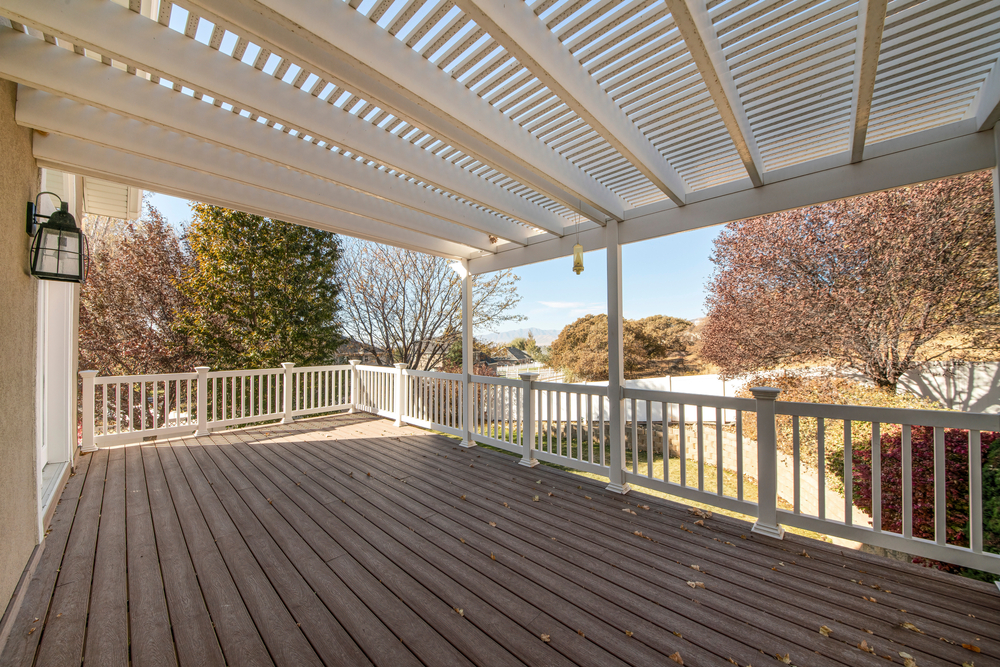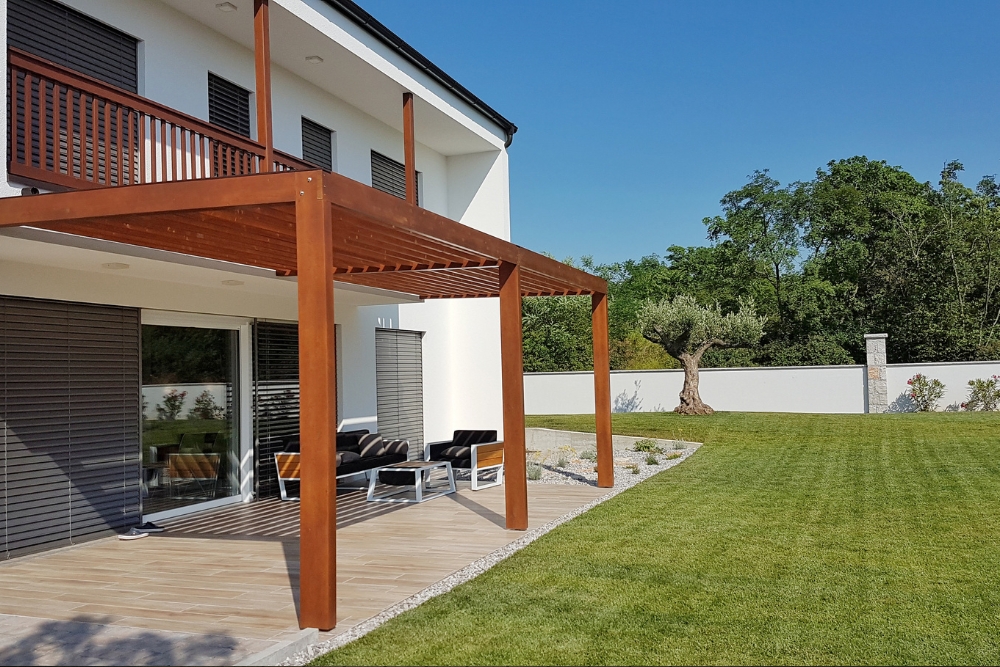Creating a space of comfort and beauty outdoors has become an essential part of making a house feel like a home. It’s about crafting areas of repose that not only stand on their own in terms of design but also meld seamlessly with the existing aesthetic of your abode. Consider the elegance of structures that, by their mere presence, can transform a plain backyard into an area of serenity.
Integration is key, with structures that communicate with your home’s architecture, creating a dialogue between the man-made and the natural. These tips aim to guide you through the process of selecting and situating the perfect addition to your outdoor realm.
Flawless integration ensures that your recreational space is not just an afterthought, but a coherent extension of your living area. Let’s explore how you can achieve this blissful design synergy, making your outdoor space a true reflection of your home’s character.
Key Takeaways
- Assess your back garden space and choose a pergola location that maximises sun exposure, complements existing features, and aligns with the size of your garden.
- Define what you want to achieve with your pergola – be it entertainment, relaxation, or dining – and select designs with appropriate materials that withstand local weather conditions.
- Ensure the design of your pergola harmonises with the architecture of your home by using similar styles, materials, and colours for a cohesive look.
- Consider incorporating versatile elements such as adjustable shades or built-in seating into your pergola design to enhance functionality in different weather conditions.
- Enhance the appeal and integrate landscaping around your pergola; consider adding greenery like plants or vines, lighting fixtures for ambience, and water features for added tranquillity.
Integrate Pergolas into Your Aesthetic
When designing outdoor spaces, it’s important to assess the space and define your functional goals. Harmonising with the existing architecture and choosing suitable materials will help create a cohesive look.
Optimising versatility and enhancing landscaping can further integrate pergolas into your home’s aesthetic.
Assess the space
Assessing the space is where we kick off our outdoor pergola design journey. We take a look at our garden, considering how much room we have and what shape it’s in. Is there a spot that catches the sun’s rays just right? Or perhaps an area that would be perfect for a tranquil garden retreat? The size of your garden might inspire a cosy corner setup or allow for an expansive American pergola style, complete with an outdoor kitchen inspiration.
We also think about what already exists in our garden. Are there trees we want to incorporate into our design or maybe existing structures to work around? Deciding on the location sets us up for success and leads beautifully to defining functional goals for our new blissful outdoor haven.
Define functional goals
When designing a pergola, we outline the functional goals to ensure its purpose aligns with your outdoor living needs. This involves determining whether you want to create a space for entertainment, relaxation, or dining.
Understanding your desired functionality helps in selecting the right layout and features for your pergola, like incorporating a louvred design for adjustable shade and sun exposure.
We also consider how the pergola will integrate with other elements of your outdoor space, such as seating areas or cooking facilities.
Incorporating water features and fire elements into the design can add ambience while ensuring that these installations are safe and compliant with regulations. Additionally, incorporating greenery into the pergola’s structure can provide natural aesthetic appeal while contributing to shading and cooling effects.
Harmonise with architecture
To ensure that the pergola seamlessly complements your home, it’s essential to harmonise its design with the existing architecture. This involves choosing materials, colours, and styles that align with the overall aesthetic of your property.
By considering elements such as rooflines, window placements, and exterior finishes when designing your pergola, you can create a cohesive look that enhances the beauty of your outdoor space while adding value to your home.
When integrating a pergola into your outdoor area, it’s crucial to keep in mind how it will blend with the architectural features of your home. This can be achieved by mirroring or complementing key aspects of the building’s design through careful material selection and thoughtful placement.
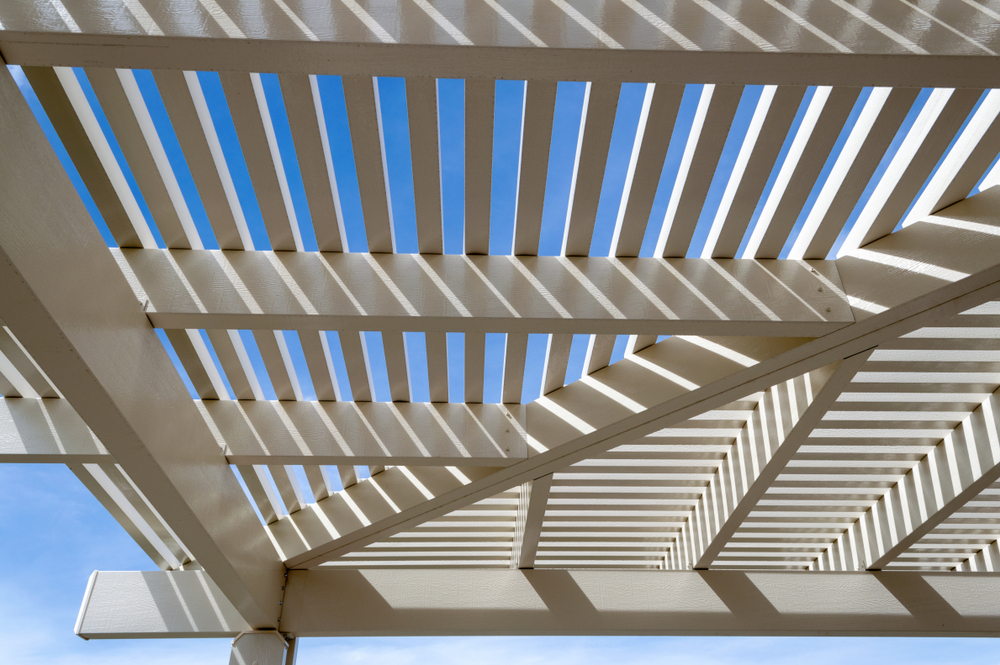
Choose suitable and aesthetic materials
When harmonising with the architecture of your outdoor space, it’s crucial to choose suitable materials for your pergola. Consider durable and weather-resistant options like cedar, redwood, or metal for longevity and low maintenance.
Assess the aesthetic appeal of different materials such as sleek aluminium, traditional timber, or modern vinyl to complement your home’s style. Taking into account the local climate and environmental factors will help you select materials that can withstand sun exposure, heavy rainfalls, or snow loads.
Opting for sustainable and eco-friendly materials not only contributes to a greener environment but can also add a unique touch to your pergola design. Incorporating recycled wood or composite materials creates an environmentally conscious structure while enhancing the visual appeal of your outdoor oasis.
Optimise versatility
When designing your pergola, consider enhancing its versatility to make the most of your outdoor space. Integrate features such as louvred pergolas or adjustable canopy systems to adapt to different weather conditions, providing shade in the heat and allowing sunlight on cooler days.
Incorporate built-in seating or storage options to maximise functionality, and consider adding lighting for both daytime and evening use. Utilising versatile design elements ensures that your pergola can serve multiple purposes, whether it’s for entertaining guests, relaxing with a book, or creating an outdoor dining area.
When planning your pergola’s versatility, think about how you can incorporate modern technology into the design. Consider integrating entertainment options such as TV setups or outdoor speakers for a truly multi-functional space.
Enhance with landscaping
To further enhance the versatility of your pergola, landscaping plays a crucial role in creating an inviting and picturesque outdoor space. Incorporating greenery around the pergola can soften its structure, adding a natural and aesthetically pleasing touch to your backyard oasis.
Lush plants, flowers, or climbing vines planted strategically around the pergola can provide shade, privacy, and seamless integration with nature. Introducing water features like a small pond or fountain near the pergola can create a tranquil ambience for relaxation or entertainment.
Additionally, incorporating fire elements such as a fire pit or outdoor fireplace near the pergola can extend its functionality into cooler evenings while creating an enchanting atmosphere.
Tips for Designing the Perfect Pergola Oasis
When designing your perfect pergola oasis, it’s important to take advantage of evening lighting to create a cosy and inviting atmosphere. You should also make sure to navigate permits and regulations before starting the project, ensuring everything complies with local laws.
Take advantage of evening lighting
Illuminate your pergola oasis with strategically placed evening lighting to create a warm and inviting atmosphere. Install fairy lights, lanterns, or sconces to add a soft glow that enhances the beauty of your outdoor space.
Utilise solar-powered options for sustainability and easy installation.
Strategically place lights around the perimeter, allowing for both functional and aesthetic benefits. Create an intimate ambience for entertaining or relaxing by incorporating dimmable fixtures while highlighting key architectural features of your pergola design.
Navigate permits and regulations
When designing your outdoor oasis, it’s important to navigate permits and regulations to ensure compliance with local building codes. Here are some tips for navigating permits and regulations when integrating a pergola into your home’s aesthetic:
- Research local building codes and zoning regulations to understand the requirements for installing a pergola in your area.
- Obtain any necessary permits before starting the construction process to avoid potential fines or delays.
- Consult with a professional contractor or architect who is familiar with local building codes to ensure that your pergola design meets all regulatory requirements.
- Consider contacting your homeowners’ association, if applicable, to seek approval and guidance regarding the installation of a pergola in your backyard.
- Keep records of all permit approvals and relevant documentation in case they are needed for future reference or inspections.
- Double-check with local authorities about any restrictions on the size, height, and location of your pergola to avoid any issues during the installation process.
Ensure proper installation

Transitioning from navigating permits and regulations to ensuring proper installation is crucial for the successful implementation of your pergola project. To guarantee a structurally sound and aesthetically pleasing outcome, it’s essential to prioritise the correct installation of your pergola.
Before beginning the installation process, carefully review and follow the manufacturer’s instructions provided with your chosen pergola kit or materials.
When installing your pergola, ensure that you have all necessary tools on hand and ideally have an additional person available to assist in holding parts together during assembly. Pay close attention to anchoring your pergola securely into the ground or attaching it firmly to existing structures such as your house.
Perform regular maintenance and care
After ensuring proper installation, it’s crucial to maintain and care for your pergola to preserve its aesthetic appeal and functionality. Here are some essential tips for performing regular maintenance and care:
- Clean the structure regularly to remove debris, dirt, and mould buildup.
- Inspect for any signs of damage, such as cracks or rot, and address them promptly.
- Apply a protective sealant or paint to prevent weathering and deterioration of the materials.
- Check the integrity of the hardware and make any necessary repairs or replacements.
- Trim nearby vegetation to prevent overgrowth that could damage the structure.
- Monitor the condition of any accessories or features attached to your pergola, such as lighting or fans, and ensure they are in proper working order.
6 Tips for Modern Pergola Design
When it comes to modern pergola design, there are several key tips to consider. From attaching the pergola to the house to using alternative materials for a unique look, these ideas will help you create a stylish and functional outdoor space.
Attached at the house
Position the pergola so that it directly attaches to the house. This connection creates a seamless transition between indoor and outdoor areas, offering both shelter and an extended living space.
Integrate the pergola into your home’s architecture by ensuring its design complements the style of your house. Consider incorporating complementary materials, such as matching colours or textures, for a cohesive look.
Dark and delightful
Position the pergola in a strategic spot to create dramatic contrast and depth. Integrate darker materials such as stained wood or metal for a bold, modern look. Emphasise the rich tones with vibrant greenery and warm ambient lighting to achieve a captivating outdoor retreat.
Incorporate dark curtains or shades for added privacy and shelter from the elements.
Enhance the ambience by adding cosy seating, statement furniture, and decorative accents in complementary hues for an inviting space that exudes elegance and charm. Use textured fabrics, rugs, and cushions to soften the overall aesthetic while maintaining a sophisticated allure.
Work with windows
The strategic placement of your pergola can significantly enhance the connection between your home’s interior and the outdoor landscape. Situating it in a spot that captures the soft play of natural light and the gentle caress of the breeze invites a harmonious blend of nature’s comforts into your living space.
Including windows within your pergola’s design goes a step further, creating beautifully framed vignettes of the surrounding scenery while flooding the area with warm, natural light.
This thoughtful positioning should also consider the symmetry and sightlines of your home’s current windows, ensuring the pergola serves as an extension of your home’s design, rather than an afterthought. By doing so, you magnify the aesthetic appeal from both the inside looking out and the outside looking in, creating a cohesive look that elevates the entire property.
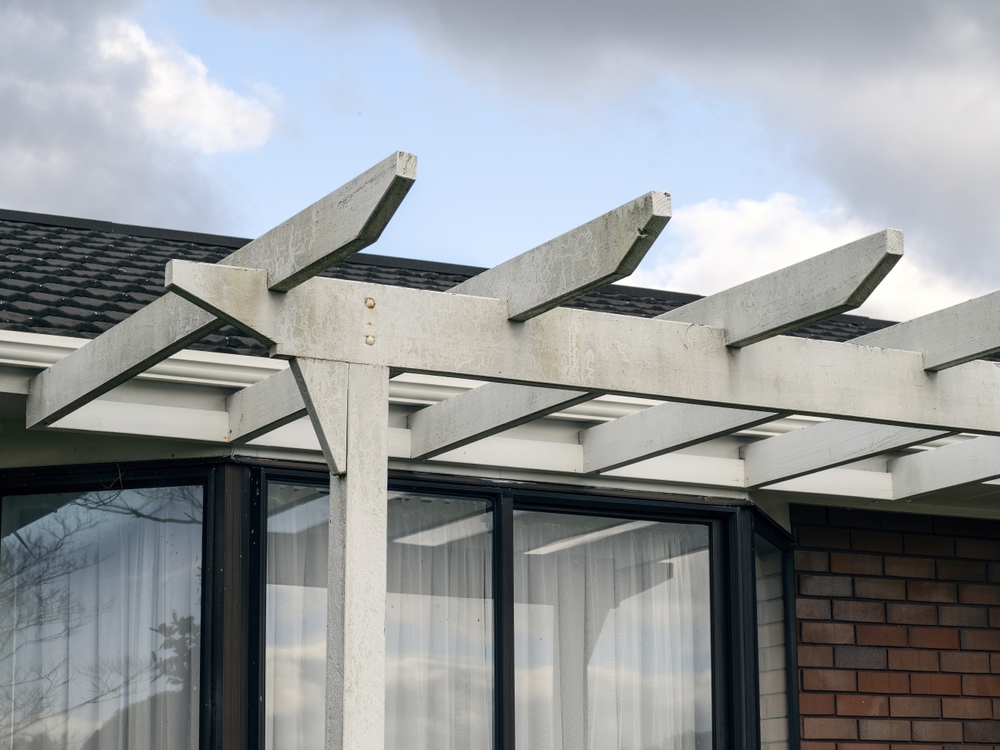
Real and rustic
When considering modern pergola design, look into infusing the structure with a real and rustic feel to bring an organic charm to your outdoor space. Utilise natural materials like weathered wood or rough-hewn beams for an authentic aesthetic that complements the surrounding environment.
Incorporate elements such as stone accents, vintage light fixtures, or earthy tones to evoke a warm and welcoming atmosphere in your outdoor oasis.
Immerse yourself in the simplicity of nature by embracing the authenticity of real and rustic features within your modern pergola design. Let the raw beauty of natural materials and earthy elements create a tranquil ambience that harmonises effortlessly with your outdoor surroundings.
Use alternative materials
Consider using alternative materials for your pergola to achieve a unique and modern look. Explore options such as aluminium, vinyl, or even recycled wood for a sustainable touch. Incorporating different materials can add visual interest and create a standout feature in your outdoor space.
Embrace creativity by mixing traditional and unconventional elements to elevate the overall aesthetic of your pergola.
To further enhance the appeal of your pergola, experiment with non-traditional materials like fabric or polycarbonate panels to provide shade and protection from the elements. These materials offer versatility while adding an unexpected twist to your design.
Raise the roof
When choosing a pergola design, consider raising the roof for added light and airflow. Opt for a higher ceiling to create an open and spacious feel, making your outdoor area appear larger.
Incorporating a raised roof in your pergola design also allows for more vertical space to hang lighting fixtures or built-in fans, adding both function and ambience to your outdoor sanctuary.
To enhance the versatility of your pergola, explore options with adjustable louvres or retractable canopies that allow you to control sunlight exposure based on your preferences. By incorporating these features into the design, you can transform your outdoor space from sheltered shade during sunny days to an open-air retreat under starlit nights.
Prioritising a higher roofline when designing your pergola offers increased comfort and flexibility while ensuring ample room for creative decor choices.
Transform Your Backyard with a Pergola and Retractable Roof
When it comes to transforming your backyard with a pergola and retractable roof, there are several important factors to consider. From permits and permissions to underground lines and frost lines, proper planning is essential for creating the perfect outdoor oasis.
Hiring a professional for installation can also ensure that your pergola and retractable roof are seamlessly integrated into your home’s aesthetic.
Consider permits and permissions
Consider local permits and permissions before installing a pergola, as regulations may vary from area to area. Check with your local council or relevant authorities to ensure compliance with building codes and standards.
Seek any necessary approvals before commencing the construction process to avoid potential legal issues later on.
Reviewing underground lines and frost lines in your yard is crucial when planning for a pergola installation. Consult with professionals to determine the appropriate depth for securing posts without interfering with utilities or being affected by freeze-thaw cycles.
Plan for underground lines and frost lines
- Survey the area thoroughly to identify the location of underground utility lines such as gas, water, and electrical lines to prevent accidental damage during construction.
- Take into account frost lines in your region to ensure that the pergola’s foundation is set at an appropriate depth, maintaining stability and durability.
- Consult with local authorities or utility companies to obtain information about the depth and location of underground lines in your back garden.
- It may be necessary to hire a professional service provider equipped with specialised equipment to locate and mark these underground utilities accurately.
- Adhering to regulations regarding the depths of footings about frost lines is crucial for structural integrity, especially in regions with extreme weather conditions.
Think about the design
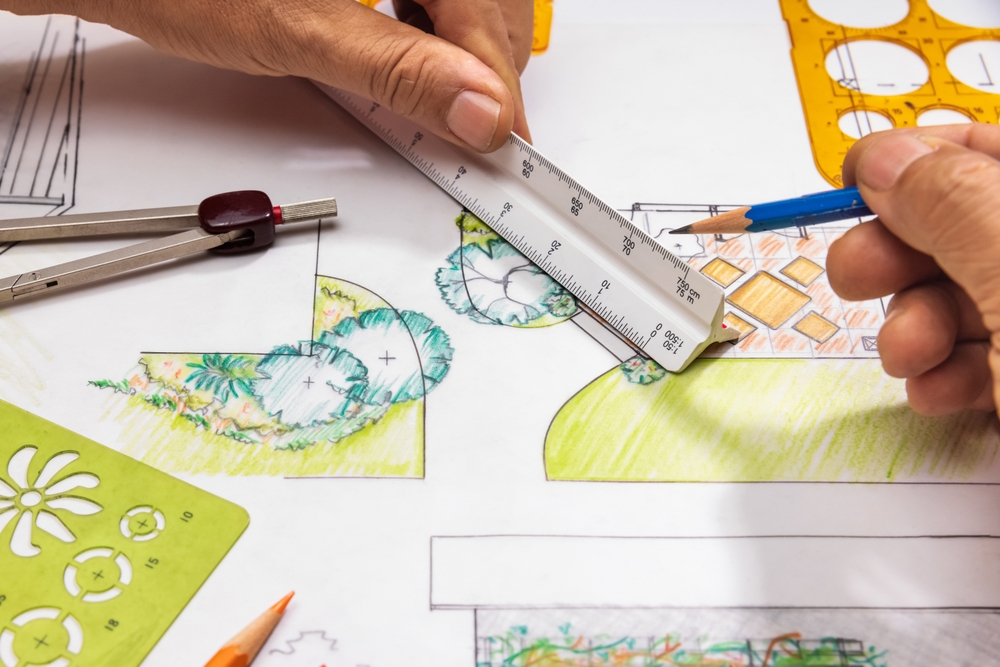
Considering the factors of underground lines and frost lines, it’s essential to also think about the design when incorporating a pergola into your outdoor space. The design of your pergola should complement and enhance the aesthetic appeal of your home while providing functionality for outdoor activities.
Incorporating elements such as water features, fire pits, and greenery can create a harmonious blend of nature and architecture in your outdoor oasis. When designing a pergola, it’s crucial to consider how you plan to use the space – whether for entertaining guests or creating a tranquil sanctuary for relaxation, ensuring that every aspect aligns with your vision.
Integrating modern pergola ideas into the design can elevate the overall look and feel of your outdoor space. From louvred pergolas to iconic styles, there are numerous options to explore that suit various architectural preferences.
Hire a professional for the installation
Considering the intricacies involved in pergola installation, it’s essential to hire a professional with experience and expertise in outdoor architecture. This will ensure that the pergola is structurally sound, complies with local regulations, and seamlessly integrates into your overall home design.
Professional installers can also provide valuable insights on choosing the right materials, optimising functionality and ensuring long-term durability. By entrusting the installation to experts, homeowners can enjoy peace of mind knowing that their pergola oasis is in capable hands from start to finish.
Furthermore, professional installation can save time and effort while minimising the risk of potential issues down the line. With their knowledge of best practices and attention to detail, skilled professionals can elevate your outdoor space by bringing your vision to life efficiently and effectively – creating an inviting retreat for relaxation or entertaining under the open skies.
Call Us!
Implementing a pergola into your outdoor space involves assessing the area, defining functional goals, and harmonising with your home’s architecture. These strategies are practical and easy to implement, ensuring an efficient process that can transform your backyard oasis.
Have you considered how these approaches could lead to significant improvements in your outdoor design? Perhaps it’s time to explore iconic pergola styles or incorporate greenery into your pergola design.
By leveraging these tips, you can create a beautiful and functional outdoor sanctuary that elevates the aesthetics of your home. Now is the perfect time to start crafting your blissful retreat!

